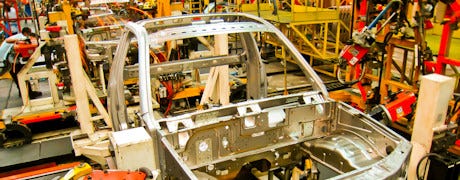
Can you use industrial processing techniques like Lean and Six Simga in agriculture? Yes, but only if farmers buy in to and commit to the processes.
The term Six Sigma came from the manufacturing industry. The maturity of a manufacturing process can be described by a sigma rating indicating its yield or the percentage of defect-free products it creates. A six sigma process is one in which 99.99966% of the products manufactured are statistically expected to be free of defects (3.4 defects per million).
Motorola set a goal of "six sigma" for all of its manufacturing operations, and this goal became a byword for the management and engineering practices used to achieve it.

GO LEAN? Manufacturing strategies like Lean and Six Sigma have a place on the farm.
Lean, on the other hand, has even more applications in businesses like farming. It looks at the expenditure of resources to accomplish any task. All activities that do not create value for the end customer are wasteful, and thus a target for elimination.
Working from the perspective of the customer who consumes a product or service, "value" is defined as any action or process that a customer would be willing to pay for.
Lean came out of Japan after WWII, when that country struggled with its manufacturing base. "Japan was looking for ways to compete with Detroit," says Jeff Haferkamp, Chief Operating Officer at FamilyFarms Group, Brighton, Ill. "In the '60s they looked to develop a system to deliver quality better than anyone in the world, and they did it with Lean techniques."
"The whole idea is to get rid of waste," he says. "In agriculture, you would look for waste in any process of your production system."
What drives this technique is VOC - Voice of the Customer. What is the customer willing to pay for? Let's say the customer is Quaker Oats and it wants that bushel of corn on its loading dock at a set time. Any activity not directly helping accomplish that task is waste in the system.
Take a look at all the steps in your production system - from seed purchase to final product delivery. Consider the "5S" approach: sort, straighten, shine, standardize and sustain. When was the last time you used that stuff in the corner of your machine shop - the stuff with the cobwebs? Turn it into money. Or, shine it up, and use it in a standardized process that can be repeated over and over.
"The 5S approach to clean up any area is a common Lean technique that can be applied to any business," says Haferkamp.
Next, consider adding Visual Management to your operation. Simply put, it means put a label on something to avoid making the same mistake over and over. Standardize signs and map processes - even landowner relations - and you start to wipe out inefficiencies. Look for ways to make something quicker so you can make more of it or reduce time needed for other things.
Lean techniques are utilized in all types of companies: hospitals, hotels, etc. - but in farming we are just beginning to crack the code. Are farmers already cost averse and fairly efficient? Could they be even more efficient by understanding logistics and standardization?
"Getting farmers to think about what they do as a manufacturing process and to incorporate these techniques into their business makes sense as farms become bigger," Haferkamp says. "That will provide more leverage over a larger base of operation."
About the Author(s)
You May Also Like






